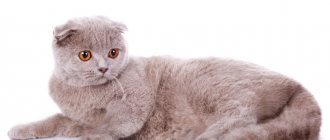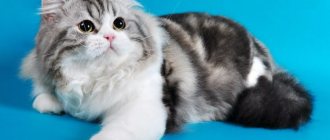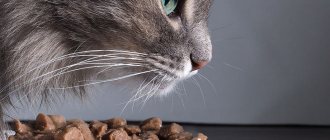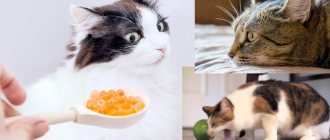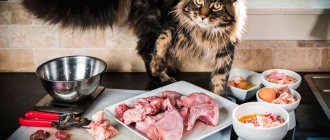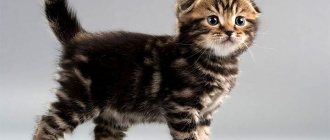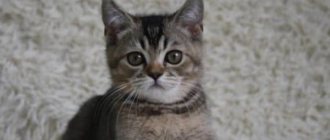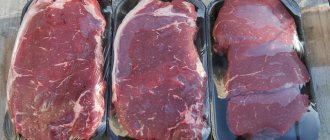The cat's immunity and health largely depend on the nature of its diet. If the body receives enough microelements and if the predator does not suffer from indigestion, it will better resist infections and is less likely to end up in the veterinary clinic due to urolithiasis or some other disease. Therefore, the issue of feeding a cat must be approached with all seriousness. What should be the proper nutrition for Scottish cats? What do Scottish cats eat? How to properly feed Scottish Folds, Scottish Straights, Highland Folds and Highland Straights?
Article continues after advertisement
How to properly feed a Scottish cat? The diet of an adult Scottish Fold and Straight-eared cat per day is 200-250 grams of food. Portions must be calculated individually: the daily dose is 3-5% of the animal’s weight. Translated into energy terms, a cat's diet has a value of 335 kilojoules. This is an average figure, because cats have different levels of activity. So, kittens, pregnant and lactating cats, as well as cats during the breeding period need 10% of their weight. For castrated, overweight, elderly and inactive cats, 2-3% is enough.
We figured out how much a cat should eat. Now let's figure out what and how to feed a Scottish and British cat at home. If in the case of ready-made food you need to follow the instructions, then you will have to balance natural food yourself.
Also, what to feed the Scottish Fold and Straight-eared depends on the presence or absence of intolerance to certain foods: if there is intolerance, this product is excluded from the menu forever. Therefore, it is easier to balance natural nutrition than factory food, because the second contains a lot of different ingredients.
Let us immediately note that cat nutrition is a very young science: it is only about 15-20 years old. Therefore, there are many unexplored issues in this topic, and even enlightened people (breeders, veterinarians and zoologists) can argue among themselves with foam at the mouth about what should be added to the cat’s diet and what should not be added, and in general about what it is like. - proper feeding. However, there are basics, which we will talk about in this article. We will not say everything that can be said, but we will give guidelines.
An excursion into the physiology of cats
The main mistake of many owners is that they believe that the human and cat organisms are very similar. In fact, humans are omnivores, and cats are obligate (“obligate”) carnivores. This means that her diet consists mainly of animal products. The stomach and short intestines of cats (2.1 meters long) easily digest proteins and fats of animal origin, but they hardly need carbohydrates.
To quickly break down proteins and destroy bacteria, a pH of 1-2 is maintained in the stomach of cats, that is, the environment is much more acidic than in the stomach of omnivores. Proteins of animal origin are considered complete for cats (containing all the necessary amino acids), and proteins of plant origin are considered incomplete. Animal proteins are found in meat and dairy products, as well as eggs. A cat's protein requirement is 40-60% of its daily diet.
Article continues after advertisement
Fats in a cat's diet are an important component: the recommended fat content is on average 15% of the daily diet, the minimum acceptable threshold is 5%, the maximum acceptable threshold is 20%. Cats, unlike humans, do not have cholesterol problems and do not suffer from heart disease due to the increased level of animal fats in their food. They need fats to obtain energy and supply fatty acids to the body (in particular, Omega-3 and Omega-6). A lack of animal fats in the diet leads to a huge number of health problems. But vegetable fats are almost useless for cats in terms of absorption of nutrients. However, they can be added drop by drop to food.
As for carbohydrates, it is worth knowing: cat saliva does not contain the amylase enzyme necessary for their digestion. And there are no enzymes at all: food passes through the oral cavity very quickly and is swallowed. In order for the carbohydrates that enter the body to be broken down, the pancreas has to work. They are broken down by its enzymes in the small intestine to glucose and other monosaccharides. If there are too many carbohydrates in the diet, then the pancreas is forced to work to the limit. But this does not mean that if you put 50% carbohydrates in your food today, your cat will get sick tomorrow. The cat's body has high compensatory capabilities and an unbalanced diet leads to consequences only if the cat sits on such a diet for a long time.
It should be noted that some breeds react less critically to an imbalance of substances in the diet, others more so. So, for example, a purebred Briton (with no Scots in his family) belongs to the first group of animals, and Scots, who often have problems with the absorption of microelements, belong to the second group.
Although a cat's body can almost completely do without carbohydrates (it can get energy from fats and proteins), in a home-based diet you can provide your pet with a small amount of them. First of all, this is necessary for easy energy production and stool formation (fiber from vegetables helps remove hair and toxins from the body and creates a feeling of satiety). Also, carbohydrate products (greens, brewer's yeast, cabbage (you can give a pinch of grated cabbage if the cat does not have gas from it) contain prebiotics that help the growth of beneficial intestinal microflora.
An experiment was conducted in which the tailed animals were asked to choose any of the proposed products. On average, cats chose the following ratio: proteins - 52%, fats - 36%, carbohydrates - 12%. The figure recommended by scientists for cat fats has been slightly overdone, but it is worth considering that the numbers are averaged and are given as a rough guide.
Thus, the physiology of a cat requires a diet consisting almost entirely of animal proteins and fats. For those who would argue that cats have been living with humans for a long time and should already have evolved to suit their type of diet, here is the opinion of zoologists: the physiology of domestic cats has changed little since domestication and is not very different from the physiology of their wild counterparts.
Features of the British digestion
Before deciding what to feed your Scottish Fold kitten, you need to take into account that up to 6 months their jaw develops and their teeth change. It is during this period that it is necessary to pay special attention to oral hygiene , providing food soft enough for comfortable chewing. You can be sure that the nutrition plan is built correctly if the following signs are not present:
- bad breath;
- saliva is released in the required quantity;
- teeth without yellow plaque and stones;
- gums are even pink;
- The kitten swallows food easily.
In addition, the number of meals is of great importance, since this breed is prone to gaining excess weight and obesity, so owners of this breed should pay special attention to the frequency and amount of food for their pet.
Natural and ready-made food
While you don’t know what Scottish Fold and Straight-eared cats eat, as well as British cats, we will say a few words about the two types of food. You should choose one of them that is closer to your lifestyle and strictly adhere to it.
The first type is natural food. But this is not food from the master's table. This is separately prepared food for the cat from certain types of meat, vegetables and dairy. Products are served without salt and spices, which are prohibited for cats. Natural nutrition must be balanced so that it contains all the necessary substances. And when feeding cats naturally, it is advisable to take courses of vitamins: this guarantees that all the microelements they need will enter the body, even if the owner has not prepared the diet correctly. Although, if everything is done correctly, and useful organic supplements are offered for food, then there is no need for synthetic vitamins. Moreover, they are absorbed worse than natural ones.
What else can you feed your Scottish cat? The second type of nutrition involves the use of ready-made food - canned food, bags and dry pads. High quality food is made in factories from similar products that we use at home. But the food is adapted for long-term storage, so you cannot call it flawless: long-term storage requires the addition of preservatives and not entirely useful substances. In addition, many feed manufacturers, in an effort to save money, use products of dubious quality.
Article continues after advertisement
EXPERT COMMENT: Yulia Prishchepa, presenter of the YouTube channel about cats “Athena-TV”
What to choose - natural food or ready-made food?
Natural food is most suitable for a cat, but you need to clearly know what can be given and what absolutely cannot be given. Also, with a natural feeding scheme, it is difficult to balance foods. For example, you need to know that if you feed your cat only raw meat, this can lead to serious health problems. Therefore, if you are a busy person or have many cats, a ready-made balanced food will suit you. If you have 1-2 cats and have time to study the intricacies of dietary nutrition, you can choose natural ones.
Industrial feed
If a person understands that he does not have time to feed his pet a variety of foods, then it is better to purchase a ready-made product. Both dry and wet food are good. In this case, you should purchase packages designed specifically for this breed. If the kittens have already been fed industrial food in the nursery, then it is better to use it.
It is highly not recommended to select cheap analogues, because they are less easily absorbed by the body and bring less benefit. It is recommended to purchase products from Hills, Royal Canin, Advance, as well as other brands that produce super-premium products. Naturally, it is necessary to select those products that are intended specifically for the Scottish Fold kitten. On the packaging you can see exactly how much food you will need to give depending on the age and weight of the animal.
How to safely transition your cat to dry food
If your pet has previously consumed natural foods, then you should not immediately feed it dry food. The transfer should be gradual so as not to cause a blow to the body. First, you need to give a small handful of dry food between feedings. The portion should be gradually increased over the course of a week. After this, several natural feedings should be completely replaced with a dry product and the body’s reaction should be observed. If everything is in order with the digestive system, then you can completely switch your pet to industrial food.
Menu and diet for Scottish cats
Food is served in the form of pieces - small or large, if the animal can tear them. Minced meat, jellied meat and liquid food are not suitable for healthy Scottish cats.
Below is a menu of natural food, which is preferable. Let's list the foods that an adult cat's diet should consist of. So, what can you feed fold-eared and straight-eared cats?
Meat (obligatory and main product)
Low-fat varieties of meat are suitable for Scottish and British cats, because... The pancreas cannot cope with excess fat, resulting in pancreatitis. Lean meats include chicken, rabbit, quail, horse meat, turkey, and some parts of beef. The ideal meat for cats is poultry and rabbit. Pork should not be given raw.
Breeders also recommend chicken. At the same time, the MURKOTIKI website, after consulting with nutritionists, does not recommend chicken that you are not sure about. According to doctors advising the site, chicken, especially broilers, contains many hormones that are fed to poultry in factories and even in households. Plus other harmful substances. Therefore, it is better to prefer turkey meat to chicken as a more environmentally friendly product. If you have access to environmentally friendly chicken, then you can and should use it.
Meat is given raw (preferred option) or boiled, but in no case fried or smoked. Whether to feed a Scottish or British cat raw meat is up to each owner to decide for himself. On the one hand, cooking kills many beneficial substances. On the other hand, raw meat sometimes contains worms, which do not always die during the obligatory three-day freezing in the refrigerator before serving to the cat. Feeding without freezing, that is, fresh meat, is prohibited.
It is worth noting that meat grown on an industrial scale most often does not contain worms. According to experts, animals in factories are prevented and fed special food, so the risk of infection is minimized. But if you give your cat hunting or farm meat, there is a possibility of infection. Not every farmer regularly prevents their animals, and they sometimes eat food that may be contaminated. Of course, this does not apply to all farms.
It is advisable to place the meat in a bowl in the form of pieces and large pieces so that the animal strengthens its chewing apparatus.
Bones are also regularly added to the diet. They are useful because cats use them to brush their teeth, and also because in the process of eating meat from a bone, or just a large piece of meat, the tailed cats develop their jaw muscles. In addition, bones contain useful substances. For this reason, an adult cat does not need to be constantly given minced meat or small pieces of meat, because... this will cause the muscles to weaken. In addition, adult cats love meat in tangible pieces more. “MURKOTIKI” has prepared a separate article on how to feed cats meat with bones, because... This is an important issue: failure to follow the rules can lead to the death of the animal!
Article continues after advertisement
Cats on a natural diet usually go to the toilet once a day or once every 2 or even 3 days - these are normal options. But you need to monitor the stool: if the cat is prone to constipation, up to 5-10% vegetables and (or) bran are added to the meat (some add porridge, but this is wrong). A cat's complete digestive cycle takes 24 hours.
Mixes are recommended as daily food for cats: pieces of meat, offal, oatmeal, raw vegetables (carrots, broccoli, pumpkin, zucchini, etc.), herbs, raw quail eggs. This mixture is prepared in advance, then frozen in the freezer in separate portioned bags, after which it is defrosted as needed, brought to room temperature and served to the pet. The meat in this mixture is raw.
Mixes are an alternative to monofeeding, when different types of meat are not mixed in one meal. Instead, they are served at different meals. This should not be confused with constantly feeding one type of meat: this is not considered a balanced diet. According to veterinarians, both mixes and monofeeding have a right to exist. The advantages of monofeeding are a happy pet, rapaciously devouring whole pieces of meat, as well as the confidence that the gastrointestinal tract will not be confused by incorrectly selected ingredients (for example, a cat may be allergic to one of the ingredients in the mix). The advantages of mixes are that the cat receives all the necessary nutrients in every meal and there is no need to draw up and keep in mind a feeding schedule.
We recommend storing excess meat in the freezer. It is advisable to pre-cut them into portioned pieces so that you can take them out one at a time.
Bran (controversial product)
Porridges are not a recommended food for carnivores, because... They are practically not absorbed and even interfere with the absorption of nutrients from other foods. With frequent consumption of grains (porridge), cats are at risk of diabetes, urolithiasis, and thyroid problems. It is better to prefer bran to porridge.
A cat can also get grains from special grass that is sprouted in a pot. The collections usually consist of wheat, barley, millet, etc. The grass is rich in vitamins and also helps the cat move the fur that has gotten into it through the gastrointestinal tract. If it is difficult to move it forward, then the cat vomits after the grass - and the fur comes out through the mouth. Therefore, every cat must have free access to grass. Just don’t bring it from the street: wild grass can contain parasites and infections.
Fish (optional)
Cats and fish are an established stereotype that has become the basis of more than one commercial. But, in fact, fish should not be a frequent guest on the cat’s table: once a week - no more. If there is an excess of fish food, kidney problems may develop, and the cat will also begin to prefer only fish products, neglecting healthier food.
Cats can only eat boiled sea fish; river and raw fish are prohibited. Firstly, such fish almost always contain parasites. Secondly, it contains a number of substances that negatively affect the digestibility of beneficial elements. Even those owners who allow the consumption of raw meat do not feed cats raw fish. Although there are some fans of a raw food diet who serve all products in an unprocessed form.
It is important to choose the right type of fish. It should not be overly oily. And it is worth considering that many types of fish (carp, pike, bream, whitefish, smelt, minnow, chub, catfish, gukuchan, ide, herring, herring, capelin, sardinella, smelt, crucian carp, perch, tench, burbot, chebak, sprat , sprat, anchovy, sorog, bream, Argentina) contain the enzyme thiaminase, which destroys vitamin B1. You can eat such fish, but not often. But you should not feed fish from the cod family, because it develops iron deficiency anemia and hair depigmentation. Salmon fish (salmon, pink salmon, trout), as well as hake, catfish, mackerel, sawfish, tuna, etc. are good for cats.
Seafood (as a treat)
Many cats happily eat squid, shrimp, mussels and rapana. Such food is not so easy for the cat’s body to digest, so it should not be the rule, but an exception in the form of a treat: once or twice a month is enough.
Article continues after advertisement
Dairy products (recommended product)
Low-fat fermented milk products (kefir, fermented baked milk, yogurt, unleavened cheese, whey, cottage cheese) are good for the health of cats: they contain a lot of protein, calcium and vitamins, and also help good digestion. It is undesirable to consume fatty dairy products, such as sour cream, in large quantities, because... this can negatively affect pancreatic health.
Let's talk separately about milk. It is not advisable to give it to adult cats. From about 3 months they develop lactose intolerance. If you want to please your pet, because... he loves this product, buy special milk or cream for cats. Read more about milk in the diet of Scottish cats.
Eggs (a must)
Chicken yolk, as well as quail yolk and white, should be a mandatory element of the Scottish cat’s diet approximately once a week. Chicken yolk should be given raw (if you are sure of its purity) or boiled; the protein is thrown away, because It's not good for cats. But a quail egg can be given whole and raw.
Raw eggs are an excellent source of vitamins (in particular, vitamins A, D, E and group B), as well as calcium, phosphorus, iodine, iron and other trace elements.
Vegetables (optional, but recommended)
Vegetables are also good for your pet: they contain fiber, which helps avoid constipation, and vitamins. B vitamins are especially important in vegetables; cats are very easily deficient in them, since they do not accumulate excess vitamins but excrete them daily. That is, B vitamins should be supplied in sufficient quantities every day. Veterinary expert Maria Dorosh recommends including vegetables in your cat’s diet, although this is not necessary.
Vegetables can be served raw or cooked. It is necessary to take into account that vitamins are destroyed during cooking, therefore, from the point of view of saturating the body with vitamins, it is better not to cook vegetables. But the starch of boiled vegetables is better absorbed, so cooking is recommended for cats who have problems digesting food: for them, boiled vegetables are a gentler option. Once your digestion returns to normal, you can switch to raw and lightly cooked vegetables. To make them easier to digest, they are added in small pinches and first grated.
Particularly useful are carrots (it is better to boil), beets (you need to boil, but this product can cause diarrhea and vomiting), cucumbers (give raw), zucchini (can be boiled and given raw), pumpkin, broccoli (lightly cooked), white cabbage (its , on the one hand, is not recommended because it causes flatulence, on the other hand, it is an excellent prebiotic, so you can periodically add a pinch of shredded cabbage).
Most often, cats refuse to eat vegetables separately, so you can mix them with meat and pour over meat broth to add flavor.
Greens (recommended product)
Cats benefit from parsley, dill, lettuce and other green foods. Sometimes cats eat them without anything. Sometimes they play with them and eat them as prey. Sometimes they are preferred instead of grass on the windowsill. Experiment.
Nutritional Supplements (Recommended Product)
You can add bran and meal (buckwheat, flaxseed, etc.) to the main diet. A pinch with food helps intestinal motility.
Dried kelp cleanses the body of toxins, helps to go to the toilet and enriches it with iodine. It is enough to periodically add a pinch to food.
Vegetable oils (hemp, sesame, sea buckthorn, olive, pumpkin, but not sunflower) deliver vitamins to the body and help digestion. But we repeat, they are practically not digestible, so it is better to prefer animal fats. However, many owners note positive changes in the coat when adding vegetable oils to the diet.
An important food supplement is fish oil (it contains fatty acids that are important for the cat’s body, including Omega-3 and Omega-6). You can purchase it as a supplement. Just keep in mind that fish oil quickly loses its beneficial properties after contact with air, so it is better to buy it in capsule form and open one at a time before adding it to food. However, cats that regularly consume fatty fish do not need a separate fish oil supplement.
Attention, life hack! It happens that you have run out of frozen meat, but you haven’t had time to prepare new meat. Then you can buy deep-frozen meat at the supermarket, defrost it and serve it to your cat.
Prohibited foods: what not to feed Scottish cats
And now about what is absolutely forbidden.
| PRODUCT | PECULIARITIES |
| Sweet | It is not allowed in any quantity. If your cat asks for sweets, it means that he is interested in something else in the product, because cats do not have receptors that recognize sweet taste. Don't buy into your cat's requests, because he can quickly develop diabetes. |
| Salty | We don’t add salt to cats’ food at all: the minimum amount of salt is contained in meat. We do not serve salty products from the store. |
| Spicy | Kittens are not allowed any spices at all. They upset digestion. |
| Onion garlic | Garlic and onions can cause serious digestive problems. |
| Chocolate | Even if your chocolate is not sweet, as it should be according to the classics, it is still under no circumstances allowed for a cat: for an animal it is poison. |
| Coffee | Just like chocolate, coffee is poison. If your cat asks you for coffee, he may be attracted to the milk you add to the drink. |
| Milk | Cats are supposed to eat fermented milk, but whole milk, which contains lactose, causes gas and stomach upset. Owners often don’t notice this, but in fact the animals don’t feel well after drinking milk. If you really want to feed your cat milk, pay attention to goat milk or a special milk replacer for cats. |
| Marinades | Cats are not allowed pickled food. This applies to any conservation. |
| Smoked | Just remember that it is poison. |
| Bold | Fatty and fried foods, no matter whether it is meat or not, are not allowed. The pancreas cannot withstand such nutrition. |
| Pork | Cats should not eat fatty parts of pork: repeated consumption of such meat can cause pancreatitis. Lean parts of pork are ok. But it’s better to bake them, because... Pigs suffer from Aujeszky's disease, which is transmitted through raw meat and is fatal to cats. |
| Canned food | Any canned product is always generously supplied with salt, spices and preservatives. This in itself is harmful even for humans, not to mention the cat’s digestive and urinary system, which is much worse adapted to such food than ours. |
| Citrus | As a rule, cats themselves cannot stand lemons, oranges, tangerines and other citrus fruits. But there are also exceptions. The fact is that citrus fruits contain harsh essential oils, which greatly affect the cats’ keen sense of smell. Plus, eating them can cause indigestion. |
| Fruits | The digestive system of cats is not adapted to eating fruits and berries, so they can cause stomach upset. But there are cats who love fruit. If nothing bad happens to them after this, you can periodically allow them to eat this. |
| Mushrooms | Mushrooms are too heavy and not healthy food for cats. |
| Potato | Potatoes are pure starch, which is difficult to digest and is not absorbed by cats. |
| Beans | Peas, lentils, soybeans and other legumes are prohibited because... These are too heavy foods, plus they cause fermentation. |
| Flour | All flour products, including bread, are harmful to cats and have no nutritional value. Instead, it is better to purchase special yeast for cats in the form of a supplement. |
Do not under any circumstances repeat what is shown in the video. The owner fed the cat sweet ice cream for the sake of a funny video.
About gluten intolerance in cats
Some people and cats suffer from gluten intolerance - gluten from wheat, rye, oats (sprouted oat grass does not count) and barley. For some, gluten can cause diarrhea, for others - constipation, for others - inflammation of the intestinal walls and other unpleasant symptoms. It is not easy to make a diagnosis, because... diagnostic methods are ineffective. It’s difficult for people to give up gluten, because everyone loves baking, but for cats it’s very easy.
The MURKOTIKI website recommends that cat breeders make allowances for the possibility of gluten intolerance in their pets and do not initially accustom them to products containing it. We are especially talking about wheat, because... it contains more gluten. That is, no bread or pasta in the diet. In addition, it is harmful even to cats that do not have gluten intolerance.
If you are using ready-made factory feeds, please note: manufacturers have already come up with gluten-free lines. Such foods are marked “no grain”, “gluten free”, “grain-free”, “does not contain gluten” and the like. Such a line of feed is available, for example, from Farmina ND, 1st Choice, Acana, Orijen, Trainer. This is a super premium and holistic food.
In the case of natural nutrition, everything is much simpler: do not add porridge from wheat, rye, oats and barley, as well as bread, to the meat. Actually, this is not recommended in any case.
Diet for aging cats
Aging cats have their own diet. As a rule, its features are associated with the fact that from 8-12 years of age (each in its own way) the animal’s overall activity decreases - and fewer calories are required. Typically, aging cats spend 60-65 kilocalories per 1 kg of body weight per day, so the diet should be reduced taking into account energy costs.
Proper food for an aging cat should be easy to chew and digest, but be rich in microelements, especially taurine, since its deficiency leads to the development of cardiomyopathy, to which, for example, Scottish cats are already prone.
If your cat has problems with teeth and gums, you need to serve ground or even liquid food.
Often, by old age, cats already have some kind of chronic diseases - the diet needs to be adjusted to take them into account.
But when a cat becomes inactive and its sexual function has faded, food often becomes the only entertainment. That's why aging cats love to eat, although they need to do it in limited quantities. What is the way out of the situation? How not to deprive an animal of the last joy in life? Firstly, at this time it is advisable to switch the cat from eating twice a day to eating in fractional portions, for example, 3 times a day. You can add more vegetables to your food, because... their volume is larger, but their calorie content is lower. But this is only in case of insatiable appetite.
And give the cat more affection, because... often older tailed animals like to eat more often also because they receive attention at this time. Let your cat associate acts of affection with more than just food.
If your cat, despite its age, is healthy, active and playful, then no dietary restrictions are required.
Description of Highland Folds
global $ads_google; //data-ad-slot=”2475549904″ $ads_google = empty($ads_google) ? false : true; ?> if ($ads_google == false) {?> $ads_google = true; ?> } ?> Body
The case dimensions are average. Visually, cats may appear large and well-fed. This impression is created due to the wide bone and long hair. However, in reality, their physique is average for a cat.
Highland Folds have a powerful neck. The limbs are of medium length, while strong and strong. The paw pads are round and soft. The width of the shoulder girdle practically coincides with the width of the croup.
Tail
The stunningly beautiful tail of Highland Fold pets is also of medium length (two-thirds of the length of the body), very flexible, tapering to the tip. The Scottish cat has a characteristic feature: it often sits on its tail and places its front paws on its stomach.
Head
The Scottish Longhair has a rounded head with well-defined cheeks, a strong chin and a prominent forehead. The nose is neat, the transition from it to the forehead has a small, barely noticeable depression. The whisker pads on the muzzle are rounded.
Ears
The ears are small and set wide apart. A distinctive feature enshrined in
standard is their form. The ears should be folded forward and downward. This feature does not appear in the Highland Fold immediately after birth, but only two to three weeks later. Some newborn kittens have ears that stand straight up, while others, on the contrary, are completely pressed to the head. In purebred cats, a change in the position of the auricle subsequently occurs, as a result of which they become lop-eared.
Eyes
They are also set wide apart and have a rounded shape. The color range of the iris varies in light shades; most often, animals with golden eyes are found. But in any case, the eye color is in harmony with the color.
Wool
Qualitative and quantitative indicators of the coat are one of the distinctive features of the Scottish breed, which appeared in the Highlands. In general, hair is of medium length, but it differs in different parts of the body. The hair on the face and paws is shorter than on the body. Particularly chic are the “pants”, “shirt front” and the tail. Noticeably long hairs grow on cats and between their fingers.
The quality of the fur is also amazing. It is very soft and silky. The undercoat of Highland Folds is well defined, and it is as soft as the main hair. Connoisseurs of the breed call the undercoat of these animals “airy, cloudy and light.”
The color of Highland Fold pets can vary over a wide range of colors. A purebred Scottish Fold long-haired kitten can be born white, red, gray, or black. The color distribution can be different: plain, brindle, spotted, marble.
At the same time, the breed standard does not allow several color characteristics:
- the presence of nonspecific white spots;
- lilac color;
- chocolate coloring;
- colorpoint colors.
Diet of sick cats
Sick and injured cats need special nutrition, which depends on the type of pathology. If you have fatty liver, you need to provide your cat with fractional meals in small portions, otherwise the disease will worsen. And if an animal has heart failure, it is recommended to switch it to a salt-free diet (that is, not only do not add salt to foods, but also choose foods that initially contain less salt: for example, give up fish).
But first, you should consult with a veterinarian, who will recommend a specific diet in your case, because sometimes an animal suffers from two diseases at once and you need to correctly combine diets.
How to feed a neutered Scottish cat
Castrated animals often suffer from the fact that they move less, and since they also lose interest in sexual hunting, the only joy in life remains food. They also disrupt the production of hormones that affect the feeling of satiety. Such animals cannot be overfed, otherwise they will become obese. But depriving them of joy is also not good, so you need to find a middle ground: you can feed a castrated cat and a sterilized cat 2-3 times a day, but in smaller portions.
The animal can also be switched to a lower-calorie diet. If this is a natural food, add more vegetables to the meat so that the amount of fiber filling the stomach is greater. If this is factory food, then there are special lines for castrates. However, they often overdo it with vegetable and grain components, as a result of which cats simply do not get enough to eat.
